

GD — Society for Dermopharmacy
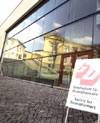 |
Issue 1 (2004) |
Dermopharmacy News
8th annual meeting of the GD in Halle / Saale
Tradition and progress in Dermopharmacy
Report by Thomas Müller-Bohn, Süsel
Following Düsseldorf, Wiesbaden, Berlin, Freiburg, Zürich, Hamburg and Bonn in the years 1997 until 2003, Halle was the venue of the annual meeting of the Gesellschaft für Dermopharmazie this year. The meeting took place in the new Auditorium Maximum of the traditional Martin-Luther University Halle Wittenberg on 30 and 31 March 2004, at which pharmacists and dermatologists have closely cooperated in the field of dermopharmacy for years. The diversified program of the meeting under the head of private lecturer Dr. med. Johannes Wohlrab expressed the interdisciplinary character of the GD and the meanwhile numerous GD activities. The meeting, visited by approximately 200 experts, had also been characterized by the impact of the Gesetz zur Modernisierung der Gesetzlichen Krankenversicherung) (GMG) (Law for the Modernization of the Legal Health Insurance).
The impact of the GMG on the dermatological therapy has been the main focus of a symposium by the GD-department Dermatotherapy in the morning of the first event day (see special report). A symposium organized by the GD-department Dermocosmetics in the afternoon of the first event day dealt with dermocosmetics for the enhancement of the dermatological therapy. The first day of the meeting has been concluded in the Schlosshotel Schkopau near Halle (see special report here...) with the ordinary general meeting and a satellite symposium organized by the company Galderma dealing with the topical therapy of onychomycoses by means of Amorolfin-nail varnish accompanied by a get-together in festive atmosphere.
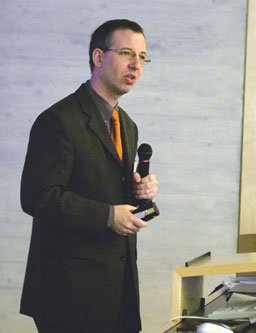 Private lecturer Dr. med. Johannes Wohlrab of the Dermatological Clinic at Martin-Luther University Halle-Wittenberg was the scientific head of the GD’s 8th annual meeting. |
The scientific main program on the second day of the meeting comprised again the entire scope of the subjects the GD deals with encompassing lectures from the sectors registration, dermopharmaceutical chemistry, biochemistry, biopharmacy, dermocosmetics, dermatopharmacology and dermatotherapy. The program has been complemented by a scientific poster exhibition and two lunchtime seminars which had been organized by Sebapharma and 3M Pharmaceuticals. While in the course of the seminar by Sebapharma news concerning the adequate care of dry skin were presented (see separate report here...), in the seminar organized by the company 3M, professor Dr. med. Hans Christian Korting, Munich, professor Dr. med. Michael Meurer, Dresden, and professor Dr. med. Harald P.-M. Gollnick, Magdeburg, acting president of the Deutsche Dermatologische Gesellschaft (DDG) (German Dermatological Society), three prominent lecturers informed about current aspects in the use of topical immuno-modulators in dermatology.
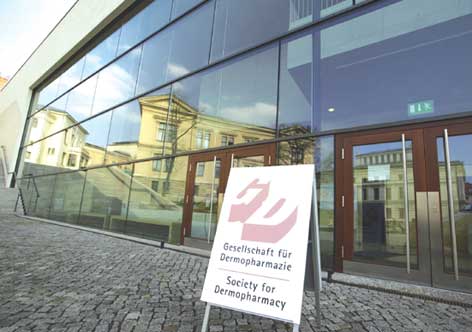 Venue of the GD’s 8th Annual Meeting was the Auditorium Maximum of Martin-Luther University Hallen-Wittenberg constructed last year. |
The GD-President Dr. Joachim Kresken, Viersen, and the scientific conference head private lecturer Dr. med. Johannes Wohlrab, Halle, stressed the interdisciplinary character of the specialized society and of the event. Kresken emphasized the fact that the entire conference had been organized as the years before without support of a third-party contractor under auspices of the GD’s commercial enterprise, the ID-Institute für Dermopharmacy GmbH. He expressed his thanks to all assistants who had been involved in the preparation of the conference, as well as the sponsors (see insertion) for their generous financial support. Professor Dr. Reinhard Neubert, prorector at Martin-Luther University Halle-Wittenberg, welcomed the members in the name of the hosting university, before later on lecturing himself about trends in the analytical assessment of active agents in skin.
Efforts in the registration
of topical dermatics
The scientific main program has been initiated with a basic lecture about the registration of topical dermatics by Dr. Jürgen Regenold, owner of a business consultancy in Badenweiler. The regulatory standards are particularly stringent for topical dermatics since besides the actual active agent also the effects contributing to the therapeutic benefit of the vehicle have to be considered. Thus a placebo for dermatics can virtually not be defined. Moreover, each prescription modification consequently represents a potential regulatory problem.
 Dr. Jürgen Regenold, Badenweiler, informed about the standards for registration of topical dermatics in Germany, Europe and the US in a basic lecture. |
Owing to this problematic nature, it is particularly recommended for topical dermatics to plan the registration strategy in time and to systematically inquire the requirements set by authorities in different steps of the procedure. Statements could be gathered from all approval authorities in the scope of a scientific advice regarding selective questions for which however considerable fees are charged. Already elaborated formulations of questions are published by the authorities in the internet.
A further important orientation aid may be furnished by guidelines which document the status of the scientific insights. Discrepancies have to be justified in the individual case. Besides national and European guidelines the guidelines of the International Conference on Harmonization (ICH) should be subject to particular consideration. The US, EU and Japan participate in this organization. Even though the standards in the US are yet more stringent than in Europe, this market should not be neglected due to economic reasons. While the difference in clinical testing concerns rather details, the standards concerning toxicology and preclinic by the US-American approval authorization FDA are particularly strict. The data accepted by the FDA in this context would in general also be sufficient for a registration in Europe.
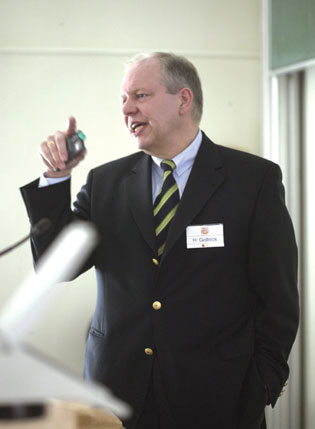 Prominence at the speaker’s desk: the acting president of the Deutsche Dermatologische Gesellschaft, professor Dr. med. Harald P.-M. Gollnick from Magdeburg, informed in a lunchtime seminar by the company 3M Pharmaceuticals about the effective principles and the therapeutic application of Imquimod-cream. |
Melanoma therapy
with dendritic cells
The lecture series regarding dermopharmaceutical chemistry and biochemistry has been organized by Dr. med. Thomas Berger of the University Dermatological Clinic Erlangen with a lecture about the generation of dendritic cells for the immunotherapy of the malignant melanoma. Despite isolated failures with this therapy approach he supports its further research. After seven years of initiation of the work a concluding judgement is not yet possible. Immunological and partly also clinical reactions can be determined at patients; however, so far no study has been able to securely prove the clinical effectiveness.
 Dr. med. Thomas Berger of the Dermatological Clinic at Erlangen University presented various procedures for the generation of dendritic cells for the immuno- therapy of the malignant melanoma. |
In a therapy with dendritic cells, immature precursor cells are taken from the patient’s periphery, charged with an antigen outside of the body, ripened and finally re-administered to the patient. In this context many method aspects are subject to further optimization. Thus it has to be analysed which precursor cells have to be charged with which antigen, the ripening mode and the way they are to reach the lymph nodes. Also the selection of the culture media is able to strongly effect the formation of dendritic cells.
Berger presented several technical realization methods for the processing of the cells. He, himself practises the application of so-called cell factories, which are uncomplex and low-priced in comparison with the alternatives and for which there are already years of experience available. Closed systems offer other solutions; however, in most cases they are more costly and partly furnish only scarce cell yields. In any case dendritic cells have to be standardized and produced by consideration of the GMP-guidelines.
Therapeutic potential of
vitamin-D agonists
Professor Dr. Dieter Steinhilber of the Institut für Pharmazeutische Chemie (Institute for Pharmaceutical Chemistry) of Frankfurt University demonstrated the therapeutical potential of Vitamin-D-receptor agonists. Vitamin D on the one side affects the calcium metabolism and on the other hand acts as proliferation inhibitor and differentiation inductor in the scope of the cell differentiation. The latter opens up the application of vitamin D at hyper-proliferating and inflammatory skin diseases such as psoriasis, however the rise of the calcium blood level limits this option. A way out is the development of derivatives which have a more selective effect on the cell differentiation.
|
Galderma Laboratorium GmbH, Freiburg 3M
Pharmaceuticals, Neuss |
The Vitamin D-agonist Calcipotriol belongs for example to the derivatives introduced in the topical therapy. Due to its low systemic bio-availability Calcipotriol has a by the factor 100 to 200 lower effect on the calcium metabolism than Calcitriol, the natural active form of vitamin D. For the systemic application several vitamin D-receptor super-agonists have been developed meanwhile, however the selectivity of these substances on the cell differentiation has to be further increased before being able to make therapeutical use of this approach.
 The conference participants were impressed by the flair of the university square in front of the Auditorium Maximum. |
Quality aspects in the
registration of dermatics
Dr. Usfeya Muazzam of the Bundesinstitut für Arzneimittel und Medizinprodukte (BfArM) (Federal Institute for Drugs and Medicinal Products) in Bonn gave an overview of the projects of his authority as first lecturer in the lecture series referring to pharmaceutical technology, biopharmacy and quality assurance. In the registration procedure besides effectiveness and safety also the pharmaceutical quality of the drug has to be established. In order to render these properties transparent, plausible and reproducible, documentations should be in accordance with the standardized scheme of the Common Technical Documents (CTD). In the end the documentation has to ensure the confidence in the drug.
The standards applying to the quality are to be met from the beginning of the pharmaceutical development via the production till the final product control and packaging. As concerns the quality there should not be any different standard levels neither between human and animal drugs nor between new and established active substances and auxiliary agents.
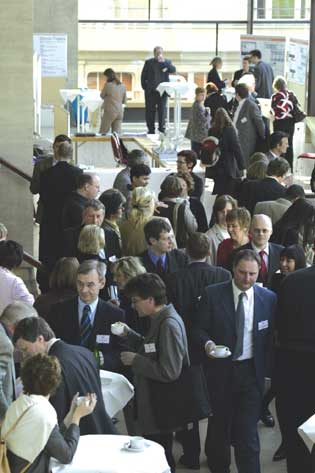 As usual at GD’s annual meetings the breaks serve as interdisciplinary and interprofessional exchange of ideas. |
Mass spectrometry
in skin analytics
In view of the stringent quality standards, effective analysis methods are required for the specific development and safety check of new dermatics and dermocosmetics. Professor Dr. Michael W. Linscheid of the Institut für Chemie (Institute for Chemistry) of Berlin University explained the way mass spectrometry is able to support dermatological research. The objective of his work is to prove DNA damage in human skin by means of mass spectrometry whereas the effect of UV-light has been investigated in the first place.
The direct DNA change by UVB and UVC radiation can be primarily noticed by means of the pyrimindindimers formed which is detectable by ESR spectroscopy. In contrast, under the influence of the UVA-radiation mainly extremely short-lived OH-radicals are generated entailing an oxidation of the DNA. The oxidation products developed can be easily proven by using mass spectrometry; this does not apply, however, to the reaction path leading to these products.
9-oxo-guanosin has been selected as principal substance for the proof of oxidative skin damage. Radiation with UV-light in presence of unmodified titan oxide entails an above proportional increase of 8-oxo-guanosin. In presence of the coated titan dioxide particles as applied in sun protection products this effect was however substantially reduced. The method represents further promising potential for the investigation of other questions, but then again following 8-oxo-guanosin additional specific indicator molecules have to be detected first. Advantageous is in any case the high sensitivity of the procedure.
Analytical trends in
dermopharmacy
In a basic lecture Professor Dr. Reinhard Neubert of the Institut für Pharmazeutische Technologie und Biopharmazie (Institute for Pharmaceutical Technology and Biopharmacy) of Halle-Wittenberg University gave an extended overview about the use of modern analytical methods in dermopharmaceutical research as first topic in the afternoon program. On the one hand separation procedures as gas- and liquid chromatography or the capillary electrophoresis can be coupled to the detection via mass spectrometry. On the other hand detection methods after IR-stimulation are suitable as the attenuated total reflection (FT-IR-ATR) or the photo-acoustic spectroscopy (FT-IR-PAS).
While the skin has to be prepared for the application of mass spectrometry, i. e. the method is only applicable ex vivo, spectroscopy methods cannot be invasively applied after IR-stimulation. Thus for example the penetration of drugs into the skin can be directly observed. However, the sensitivity of this non-invasive method needs to be further improved. In contrast the linking methods are particularly characterized by their increased specificity and sensitivity. They are virtually universally applicable for detection and may serve both as structure analysis and quantitative analytics.
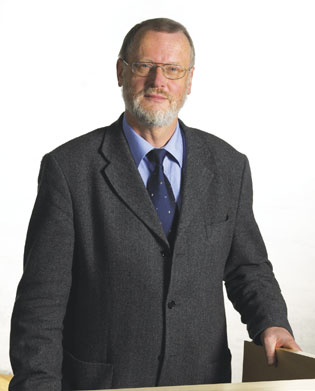 The prorector of Martin-Luther University Halle-Wittenberg, professor Dr. Reinhard Neubert from the Institut für Pharmazeutische Technologie und Biopharmazie (Institute for Pharmaceutical Technology and Biopharmacy) held a basic lecture about trends in analytical determination of active agents in human skin. |
Legal definition of
dermocosmetics
While novel research is often at the same time interesting for the dermopharmaceutical and dermocosmetic approach, an evident differentiation is to be made between dermocosmetics, medicinal products and dermatics in legal aspects. The criteria for the definition of these three product categories from the view of surveillance authorities were described by the pharmacist Rudolf H. Völler from the Regierungspräsidium (Administrative Headquarters), Darmstadt.
According to the drug law in force at present it has to be tested first of all by means of the standards stipulated in the Lebensmittel- and Bedarfsgegenständegesetz (Food and Consumer Goods Law) respectively the Medizinproduktegesetz (Medicinal Product Law) whether a preparation is subject to this regulation and therefore is a cosmetic or a medicinal product. Otherwise it may be concerned by the drug law. According to the new drug definition of the EU, as outlined in the guideline 2001/83/EG, this sequence will be reversed in the future. Then tests will be performed first as to detect whether the product in question is a drug.
 Pharmacist and foodstuff chemist Rudolf H. Völler from the Regierungspräsidium (Administrative Headquarters), Darmstadt, explained the criteria for the legal definition of dermocosmetics, medicinal products and dermatics from the view of the surveillance authorities. |
In order to reduce the number of regulations which have to be complied with from the perspective of the producer, the sequence first a cosmetic, then a medicinal product and last a drug should be strived for. The condition for a product to be categorized as cosmetic is that it is not predominantly used for medicinal purposes. In borderline cases the number of indications in the package insert and on the packing itself may be decisive for this classification. In contrast to cosmetics, medicinal products offer wide-spread possibilities of making statements about the effect. This, however, may not be based on a pharmacological, immunological or metabolic effect. Distinct from cosmetics, medicinal products require a registration, a system for quality assurance and a CE-labelling.
For the classification of the legal status, the customers’ dealing with the product or the consumers’ expectation to the product is often essential. In fact these criteria may be controlled by publicity, but the latter may also arouse false expectations. In case of a subsequent modification of a product (for example from a drug to a cosmetic) a lapse of time for the alteration of the consumers’ expectation has to be considered. In such cases, Völler recommends a publicity interruption of half a year to one year. After that it should be possible to re-position a product to the consumer with a new intended purpose.
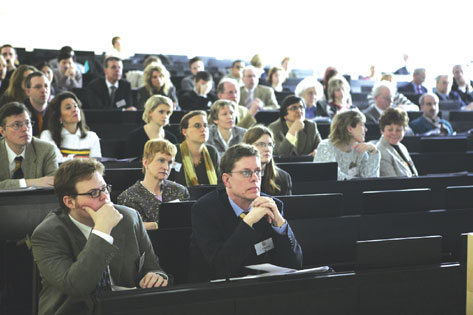 Approximately 200 dermatologists, pharmacists and other experts followed the varied lecture program of the GD’s 8th annual meeting. |
Assessment of cosmetics
by Öko-test
Apart from the lectures by researchers, practitioners and experts from clinic and industry, the GD-meeting equally offered a forum for crucial statements from an unusual perspective this year. Kerstin Scheidecker, Frankfurt, editor of the newspaper Öko-Test presented criteria according to which Öko-Test evaluates cosmetic and personal hygiene products. The assessments are not based on own scientific investigations but rely on published data.
The newspaper Öko-Test sees itself as representative of a critical consumer community which does not merely base its buying decision on the price of a product as selection criterion. The standards for cosmetics are deliberately higher than solely complying with legal stipulations. Such higher standards had in the past anticipated bans realized later on. In case there is a well-founded suspicion for damage, the pertinent active ingredient of a cosmetic is to be generally refused. However, the suspicious facts have to be legally tenable.
Scheidecker emphasized that Öko-Test does not in the least exaggerate in its assessment of cosmetic active ingredients. Thus only 14 of 26 fragrances which have to be labelled in the future have been subject to criticism. Moreover, Öko-Test does not object to the use of parabens as preservative. The fact that these substances have been recently proven in breast cancer does not prove coherence with the application of paraben-containing cosmetics.
Criticized are, however, for instance aromatic amines, allergy triggering scents, formaldehyde-splitting substances, paraffins and basically all substances which could accumulate in the human body. Emulsifiers on basis of polyethylene glycol (PEG) are refused due to the fact that some of them are able to infiltrate other substances into the body. Distinct to drugs there should be no benefit-risk assessment for cosmetics, cosmetics should be safe under all circumstances.
In the following controversial discussion professor Dr. Reinhard Neubert defended the use of paraffins in cosmetics and refused the general replacement of these components by natural vegetable oils as demanded by Öko-Test. The partly unsaturated combinations of vegetable oil would in fact induce biological reactions and thus counteract the intended objective. Further, PEG-emulsifiers, proven in pharmacy, should not be generally condemned. As stressed by the GD in a guideline already published in 2001, the risk of an undesired penetration enhancement triggered by PEG-emulsifiers may be excluded if the remaining ingredients of the formulation are carefully selected.
Objectification of
sensorial irritation
Dr. med. Walter Wigger-Alberti of the contract research organization proDerm in Schenefeld near Hamburg introduced test methods by means of which a sensorial irritation can be objectified. Since roughly half of the population experiences or denominates its skin as sensitive there is a huge demand to test the suitability of dermocosmetics for this group of consumers.
 The GD’s
general meeting and a satellite symposium dealing with the topical
therapy of the onychomycosis by means of Amorolfin nail polisher took
place in the evening of the first event day at the Schlosshotel Schkopau
near Halle. It was accompanied by a festive get-together.
The GD’s
general meeting and a satellite symposium dealing with the topical
therapy of the onychomycosis by means of Amorolfin nail polisher took
place in the evening of the first event day at the Schlosshotel Schkopau
near Halle. It was accompanied by a festive get-together. |
The stinging test belongs to the few methods by which the sensitivity in the area of the particularly relevant facial skin can be tested. It is based on a special sensitivity of approximately 20 percent of the population which are denominated as stinger. Stingers feel a subjective irritation in form of stabbing or burning within at least 15 minutes after the application of a five-percent lactic acid preparation on the facial region nose, cheek.
By means of the stinging test established by proDerm the irritative effect of a preparation on sensitive skin can be tested. In order to obtain objective and reproducible results, the test conditions have to be thoroughly fixed and particularly suited probands have to be selected. The test is always performed as half-side comparison. By more frequent application, the probands get increasingly sensitive. Therefore, tests have to be made at the same probands again and again, to detect whether they are still able to distinguish between irritating and non-irritating preparations.
Impact on the atopical
eczema by ceramides
Dr. med. Joachim Fluhr from the Dermatological University Clinic, Jena, presented investigations concerning the effect of barrier lipids on the atopical eczema at children. As the lipid barrier of skin is partly severely damaged in case of atopy, it is obvious to support the treatment by means of care products containing barrier lipids. Whereas at persons with intact skin the essential barrier components cholesterol, ceramides and free fatty acids are present in an approximately equimolar relation, cholesterol and free fatty acids are increasingly produced at barrier interferences. In contrast with atrophy in particular the ceramides 1 and 3 are reduced.
Thus it suggests itself to treat atrophy-damaged skin with preparations oriented in their composition on barrier lipids featuring a high content of ceramides. In an open uncontrolled study good results have been realized with such preparations. This however, according to estimation by Fluhr, only represents a first approach for future care strategies as the structure of ceramide fractions can be further optimized. In general w/o preparations with high water content and a high moiety of moisturizers have proven successful with persons suffering from atopical dermatitis.
A separate article about endocannabinoid substances for inflammatory skin diseases informs in detail about the following lecture by professor Dr. Lajos Kemeny from the Dermatological Clinic Szeged, Hungary.
Quality comparison
of psoriasis studies
Professor Dr. med. Thomas L. Diepgen of the department Klinische Sozialmedizin (Clinical Social Medicine) at the University Clinical Center Heidelberg started the lecture series in the field dermatopharmacology and dermatotherapy. He presented an investigation concerning the quality of publications dealing with psoriasis studies, the EDEN Psoriasis Survey. The results are of interest both from the perspective of the research of the disease and also in view of the general quality assurance of clinical studies.
The investigation covers 515 studies selected from 422 publications which came out in the period 1977 to 2000. Merely 249 of these studies were randomized and only in 85 studies a number of patients exceeding 50 were involved. 55 different treatment methods have been tested, among them 48.2 percent of topical therapy cases, in 30.1 percent systemic therapies and in 18.5 percent UV-radiation. The study duration was on average seven weeks. The therapy results have been measured 171 times by means of altogether 44 different score systems. Thereby the PASI-score, which had been applied 83 times, dominated significantly, however it had only been validated once. The quality of life served solely in one study as target figure, economic data have not been raised in any of the studies.
Apart from the minor extent and short duration of the studies Diepgen criticized the frequently insufficient presentation of the study design and the patient recruiting, the heterogeneous selection of the outcome and the frequent selection of placebo as standard of comparison in lieu of an established therapy. Therefore he called for a formulation of quality criteria for the realization of randomized studies concerning psoriasis and a definition of clinically more relevant outcome parameters for future studies.
Interleukine-10 as new
therapy approach at psoriasis
According to this extended evaluation of the quality of psoriasis studies, Dr. med. Wolf-Dietrich Döcke with Schering AG Berlin introduced an innovative approach in the psoriasis therapy with Interleukine-10 (IL-10). The treatment is based on the establishing that this cytokine is present in the skin of psoriasis patients in reduced concentration. This fact is astonishing as with inflammatory diseases normally the anti-inflammatory cytokines, such as IL-10 are over-exprimized. Thus the hypothesis is obvious to explain the psoriasis by a relevant shortage of IL-10 and to base the treatment on an IL-10 substitution.
In a pilot study and an open phase-II study comprising ten patients over the period of seven weeks, IL-10 has been well tolerated at subcutaneous application. Döcke described the effect as moderate. The PASI-value has been reduced but a recovery could not be observed. In a placebo-controlled double-blind phase-II study over the period of up to four months, IL-10 extended the disease-free intervals. As feasible target structures of this treatment T-cells, the antigen-presenting cells and the keratinocytes are subject to discussion.
Saint-John’s-wort cream for
the therapy of neurodermatitis
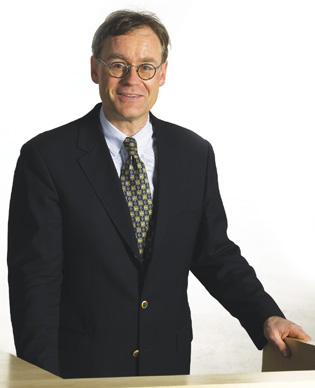 Professor Dr. med. Jan Christoph Simon since a short time director at the University Dermatological Clinic Leipzig informed about a study on the effectiveness of a Saint John’s wort (hypericum) cream at the atopical eczema which had been performed during his time at the University Dermatological Clinic Freiburg. |
Professor Dr. med. Jan Christoph Simon of the University Dermatological
Clinic Leipzig informed in the last lecture at the GD’s Annual Meeting
about a study regarding the effectiveness of Saint-John’s-wort at
the atopical eczema. The study design was based on investigations concerning
the anti-inflammatory and anti-bacterial effect of the Saint-John’s-wort
ingredient Hyperforin.
A Saint-John’s wort cream standardized on 1.5 percent Hyperforin
has been tested in a prospective double-blind half-side comparison at
subacute atopical dermatitis compared to placebo encompassing 18 patients.
In the evaluation by means of the modified SCORAD-index the Saint-John’s-wort
preparation has been significantly superior in the course of one, two
and four weeks. In the colonization of the skin with staphylococcus aureus
the verum was equally superior, however not significantly. In view of
these results more comprehensive studies seem justified.
top